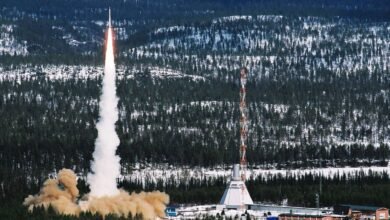Spooky fireball blazes across Lake Erie a week before Halloween (video)

On Monday (Oct. 21) night, a bright fireball could be seen streaking across the skies over Lake Erie in the U.S. and Canada.
Over 550 witness reports of the meteor were submitted to the American Meteor Society’s (AMS) “Report a Fireball” webpage; the object could be tracked moving from northeast of Cleveland, Ohio, to just west of Erie, Pennsylvania. The event occurred around 7:00 p.m. EDT (2300 GMT) on Oct. 21. Accounts of the fireball came from viewers as far east as Philadelphia, Pennsylvania and as far south as Madison, North Carolina — nearly 400 miles (640 kilometers) away.
“The overwhelming colour was light green but there did appear to be yellow/golden sparks falling from it,” wrote Brian F. in the remarks of their report to AMS from Ontario, Canada.
Fireballs falling toward Earth like this aren’t entirely uncommon, but are nonetheless rare events to witness. They’re known as bolides and appear as bright streaks across the sky, explosively incinerating from the molten heat of friction from slamming into Earth’s atmosphere at interplanetary speeds.
Peter Brown, a meteor scientist and planetary astronomer at Western University, in Ontario, Canada, posted a video of the fireball on X, formerly Twitter, captured by the university’s meteor network. “Bright fireball just after sunset witnessed by many in S. Ontario and OH/PA. Meteor occurred entirely over Lake Erie, ending near 30 km altitude N. of Ashtabula, OH dropping meteorites into lake,” Brown said in his post.
Related: Loud meteor explosion shakes Indiana with surprise boom
Bright fireball just after sunset witnessed by many in S. Ontario and OH/PA. Meteor occurred entirely over Lake Erie, ending near 30 km altitude N. of Ashtabula, OH dropping meteorites into lake. Video from several @westernu meteor network caught the event in bright twilight. pic.twitter.com/v4DoVhiNetOctober 22, 2024
“I hear a bang from my right and saw the meteor breaking into green pieces, maybe 5 or more,” said Murray D. in their AMS report remarks.
Theirs was one of only a small handful of reports that included witnesses physically hearing the phenomenon. Explosive “bangs” or “booms,” known as “air bursts,” often accompany these fiery reentries, as external temperatures and pressures on the descending space rocks lead to explosive incineration.
“It was big and low. For a couple seconds, I thought it was going to hit the Earth. It was huge, nothing like the casual meteor shower which I have seen many times,” wrote Kammie J., in the remarks of their report to AMS.



